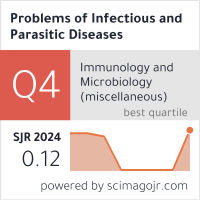ANNUAL ANALYSIS OF PARASITIC INFECTIONS IN BULGARIA IN 2022
DOI:
https://doi.org/10.58395/5hpwmk26Keywords:
parasitic diseases , incidence, prevalence, zoonosesAbstract
INTRODUCTION: Infections caused by parasites still represent an important global health problem. Although parasitic infections are responsible for significant morbidity and mortality in developing countries, they are also prevalent in developed countries. This study aims to establish the dynamics of the parasitic infections registered in the country (local and imported) and to analyze the situation, based on data from the previous years.
METHODS: We used the annual reports of regional health inspectorates, diagnostic laboratories, medical universities, and data from the National center of infectious and parasitic diseases about all individuals infected with parasitic diseases in the country.
RESULTS: A total of 635,522 persons were examined in 2022, of whom 1.82% were diagnosed with various parasitic infections. In the local helminthic zoonoses such as echinococcosis and trichinellosis, a significant decrease in morbidity was observed,1.3%₀₀₀ (n = 89) for cystic echinococcosis and 0.16%₀₀₀ (n = 9) for trichinellosis. For soil-transmitted helminthiases (ascariasis and trichuriasis), the incidence was 6.7%₀₀₀ and 0.5%₀₀₀, respectively. Data on enterobiasis does not show any particular dynamics in 2022 either. The registered prevalence for the country was 1.48%, and for children from various childcare facilities - 2.45%. During the year, seven cases of vector-borne parasitic diseases were registered in the country: imported malaria was diagnosed in 5 patients (4 Bulgarian citizens and one foreigner), and autochthonous visceral leishmaniasis - in two persons.
CONCLUSIONS: The analysis shows that, in spite of a trend of declining morbidityfor some socially significant protozoan and helminth infections, human parasitic diseases still represent a significant problem with social and medical consequences for the population of our country. Therefore, it is necessary to preserve and strengthen the surveillance and control network by including new personnel in the medical parasitology structures.
Downloads
References
Satoskar AR, Simon GL, Hotez PJ, Tsuji M. Medical parasitology. CRC Press, Boca Raton, USA 2009, 318 pp.
Ung L, Stothard JR, Phalkey R, Azman AS, Chodosh J, Hanage WP, Standley CJ. Towards global control of parasitic diseases in the Covid-19 era: One Health and the future of multisectoral global health governance. Adv Parasitol. 2021;114:1-26.https://doi.org/10.1016/bs.apar.2021.08.007
Rainova IG, Harizanov RN, Tsvetkova ND, Kaftandjiev IT, Enikova RB, Ivanova M, Videnova MV, Kaneva EM, Mikov OD. Epidemiological Indicators of the State of Cystic Echinococcosis in the Republic of Bulgaria for the Period 2011-2020. International Journal of Echinococcosis 2022;1(2):26-32.https://doi.org/10.5455/IJE.2022.03.05
Harizanov R, Rainova I, Tsvetkova N, Kaftandjiev I, Borisova R, Videnova M, Kaneva E, Mikov O, Ivanova A, Yakimova V. Prevalence of parasitic pathology among humans in Bulgaria: A retrospective cohort study over two years ( 2020 – 2021). Problem Inf. Parasite. Dis. 2022; 50(2): 26-34.https://doi.org/10.58395/pipd.v50i2.93
European Food Safety Authority, European Center for Disease Prevention and Control. The European Union One Health 2021 Zoonoses Report. EFSA Journal 2022;20(12):7666. https://doi.org/10.2903/j.efsa.2022.7666
Rainova, I., Harizanov, R., Tsvetkova, N., Borisova R, Kaftandjiev I, Kaneva E, Ivanova A, Mikov, O., Videnova, M. Status of parasitic diseases in Bulgaria in 2018. General Medicine 2020; 22(1): 13 – 18.
Rainova I, Harizanov R, Kaftandjiev I, Tsvetkova N, Mikov O, Kaneva E. Human Parasitic Diseases in Bulgaria 2013-2014. Balkan Med J, 2018, 35, 61-67.https://doi.org/10.4274/balkanmedj.2017.0167
Pappas G, Roussos N, Falagas ME. Toxoplasmosis snapshots: global status of Toxoplasma gondii seroprevalence and implications for pregnancy and congenital toxoplasmosis. Int J Parasitol, 2009, 39, 1385-1394.https://doi.org/10.1016/j.ijpara.2009.04.003
Kaftandjiev I, Harizanov R, Rainova I, Mikov O, Tsvetkova N, Borisova R, Kaneva E. Epidemiological and clinical characteristics of imported malaria in Bulgaria: A retrospective study of a 21-year period. Travel Med Infect Dis. 2022; 49:102400.https://doi.org/10.1016/j.tmaid.2022.102400
Huang Q, Xu WJ, Wang XX, Zhang X, Pan KN, Zhang JQ, Chen HL, Ruan W, Yao LN. SARS-CoV-2 and Plasmodium falciparum Co-Infection in a Returning Traveler. Front Public Health. 2022;10:871374.https://doi.org/10.3389/fpubh.2022.871374
Downloads
Published
Issue
Section
License
Copyright (c) 2024 Rumen Harizanov, Mihaela Videnova, Ognyan Mikov, Iskren Kaftandjiev, Aleksandra Ivanova, Eleonora Kaneva, Raina Borisova, Nina Tsvetkova, Iskra Rainova, Violeta Yakimova (Author)

This work is licensed under a Creative Commons Attribution 4.0 International License.






